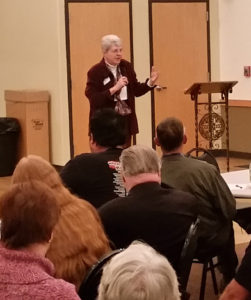By Deacon Derick Cranston
For The Catholic Messenger
RIVERSIDE — Dubbed “The Ten That Can’’ by St. Mary Parish Riverside council member Dee Simon, representatives and pastors from 10 parishes gathered at the Riverside parish Nov. 19 for a presentation on rural life. The 10 parishes are Columbus Junction, Hills, Lone Tree, Nichols, Richmond, Riverside, Washington, Wellman, West Branch and West Liberty. These 10 parishes have been tasked with sharing ideas and resources in anticipation of the decreasing number of active priests in the Davenport Diocese.

Sister Margaret Wick, OSF, of Dubuque, speaks about rural parish life Nov. 19 at St. Mary Parish in Riverside.
After sharing a meal of warm dishes, a variety of desserts and beverages, the parishes’ representatives listened to Franciscan Sister Margaret Wick’s presentation on rural parish life. Sr. Wick, a member of the Dubuque-based Sisters of St. Francis, taught sociology at Briar Cliff College in Sioux City, Iowa, and then served as academic dean and later as president.
Earlier this year she approached Kent Ferris, Social Action director for the Davenport Diocese, and asked if she could do a study of rural life in the diocese. “It was amazing to be approached by someone with such a strong faith life and background in sociology,” said Ferris. “Her effort provides a beneficial perspective for our office, our parishes and our diocese.’’
She chose to do the study in the Davenport Diocese after discovering that, according to the 2010 census, southeast Iowa had the highest number of families in the state living in poverty. Despite the poverty rate, Sr. Wick’s message was that evangelization is alive and well in small rural communities.
“The Church needs to pay attention to all the good things going on in these parishes,’’ she commented. During her study, she visited 10 different clusters of parishes and was impressed by what she found. “I visited one of the poorest counties in the state and was surprised by the vibrancy and life I found at the parish. There is more to the picture than the statistics show.’’
She said 22 clusters, groups or shared staffing arrangements involve 53 of the diocese’s 79 parishes. As for the rural parishes, “Not all rural parishes are alike. There is diversity in the size of the towns and parishes. Rural parishes are located in towns that range in population of less than 100 people to towns with a population of over 3,700 people. There are differences based on where people work, multiple school districts within parish boundaries, services available, where they gather, and even landline telephone exchanges. Not all people have cell phones, especially the elderly.’’
One pastor told her that a town eight miles away in his cluster is part of a different telephone network and requires a long-distance call between the two towns. “It makes people hesitant to call me,’’ he said. Another factor is where people work. In some rural parishes near Iowa City a majority of the parishioners are employed at the University of Iowa. In other parishes the majority of parishioners are farmers, while in other parishes a majority of the parishioners work at a local factory.
Sr. Wick said she got a sense of what life is like at these parishes by visiting them and reading their parish bulletins. She learned of many church dinners and festivals, signup sheets for volunteers and collections for local food pantries. In addition, the bulletins advertised events at other parishes they had no affiliation with. Also, a spirit of ecumenism was prevalent in many of the rural parishes she visited since many worked together with ministerial associations to provide for local charities or food pantries.
All of this produced strong community bonds and widespread awareness of needs and concerns.
This was an advantage that rural parishes have over larger urban parishes, she observed. At times, it can be a disadvantage. “People who lose a job or suffer from huge debt may be reluctant to ask for help because they are embarrassed. They do not want people to know the problems they are having. In a small community, word gets around fast,’’ she said.
Rural parishes also have an impressive global outreach. One example is that many of the rural parishes are sending aid to Haiti. Another example she gave was of a parish that had a Nigerian priest years ago.
The parish developed a relationship with a community in Nigeria and would send whatever aid it could. After the Nigerian priest left, the parish maintained its relationship with the Nigerian community and still sends assistance whenever possible.
At the end of her presentation Sr. Wick invited people to share observations or questions. A number of people expressed frustration at the failure to utilize lay parishioners who had gone through the diocese’s Ministry Formation Program. “These people spend their money and their time going through the program and then cannot find a job at a parish,’’ an audience member said.
Sr. Wick pointed out that the lay parish life coordinator (a position she found in several clusters she visited) might be a model for the future with the decreasing number of active priests. Other people expressed their appreciation to Sr. Wick for coming from another diocese to do her research. They felt this provided for a fresh and unbiased look at rural parishes.








